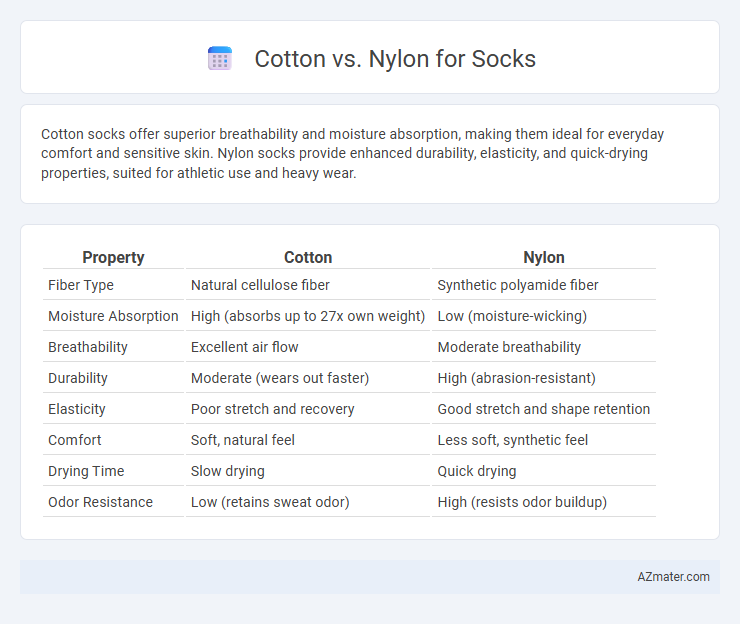Cotton socks offer superior breathability and moisture absorption, making them ideal for everyday comfort and sensitive skin. Nylon socks provide enhanced durability, elasticity, and quick-drying properties, suited for athletic use and heavy wear.
Table of Comparison
| Property | Cotton | Nylon |
|---|---|---|
| Fiber Type | Natural cellulose fiber | Synthetic polyamide fiber |
| Moisture Absorption | High (absorbs up to 27x own weight) | Low (moisture-wicking) |
| Breathability | Excellent air flow | Moderate breathability |
| Durability | Moderate (wears out faster) | High (abrasion-resistant) |
| Elasticity | Poor stretch and recovery | Good stretch and shape retention |
| Comfort | Soft, natural feel | Less soft, synthetic feel |
| Drying Time | Slow drying | Quick drying |
| Odor Resistance | Low (retains sweat odor) | High (resists odor buildup) |
Introduction to Cotton and Nylon Socks
Cotton socks offer breathability and natural moisture absorption, making them ideal for everyday comfort and moderate activity. Nylon socks provide enhanced durability, elasticity, and moisture-wicking properties, often favored in athletic and performance settings. Both materials impact sock comfort and functionality, influencing choices based on activity level and environmental conditions.
Material Composition and Properties
Cotton socks are made from natural cellulose fibers, providing excellent breathability, moisture absorption, and softness, which enhances comfort and reduces skin irritation. Nylon socks, composed of synthetic polyamide fibers, offer superior durability, elasticity, and moisture-wicking properties that keep feet dry and maintain sock shape over extended use. The blend of cotton with nylon often combines the advantages of both materials, balancing comfort with strength and stretchability for enhanced performance in various activities.
Comfort and Wearability
Cotton socks offer superior breathability and moisture absorption, making them ideal for comfort in everyday wear and mild activities. Nylon socks excel in durability and elasticity, providing a snug fit that resists wear and tear during intense physical activities. For optimal comfort and wearability, blending cotton with nylon often combines softness with enhanced strength and stretchability.
Moisture Wicking and Breathability
Nylon socks offer superior moisture-wicking properties compared to cotton, effectively drawing sweat away from the skin to keep feet dry during intense activities. Cotton, while breathable, tends to retain moisture, which can lead to discomfort and increased risk of blisters. For optimal foot dryness and ventilation, nylon blends are preferred in performance and athletic sock designs.
Durability and Longevity
Nylon socks offer superior durability and longevity compared to cotton, as nylon fibers resist wear and tear from friction and repeated washing, maintaining their shape and integrity over time. Cotton socks, while breathable and comfortable, tend to wear out faster due to fiber breakage and shrinkage after multiple washes, leading to thinning and holes. For long-lasting sock performance, nylon blends enhance strength and extend the lifespan beyond what pure cotton can provide.
Odor Control Performance
Nylon fibers offer superior odor control compared to cotton due to their moisture-wicking properties and resistance to bacterial growth, which reduces the buildup of sweat-related odors. Cotton, while breathable and comfortable, tends to retain moisture, creating an environment conducive to odor-causing bacteria. Athletic socks often blend nylon with antimicrobial treatments to combine durability, moisture management, and odor resistance for enhanced performance.
Skin Sensitivity and Allergies
Cotton socks are highly breathable and hypoallergenic, making them ideal for individuals with sensitive skin or allergies, as they reduce irritation and moisture buildup. Nylon socks, while more durable and moisture-wicking, can sometimes cause skin reactions due to synthetic fibers and less breathability. Choosing cotton over nylon can significantly decrease the risk of allergic dermatitis and improve overall foot comfort for sensitive skin.
Maintenance and Care Tips
Cotton socks require gentle washing in cold water to prevent shrinking and maintain softness, while nylon socks benefit from low heat drying to preserve elasticity and avoid fiber damage. Avoid using bleach on both materials to extend the life of the socks and retain color vibrancy. Frequent rotation and air drying are recommended to minimize wear and maintain sock integrity in both cotton and nylon varieties.
Environmental Impact Comparison
Cotton socks generally have a higher environmental footprint due to intensive water usage, pesticide application, and land consumption during cotton cultivation, contributing to soil degradation and water scarcity. Nylon socks, made from synthetic polymers derived from petrochemicals, require less water but rely heavily on fossil fuels, leading to significant greenhouse gas emissions and non-biodegradable waste. Biodegradability and recyclability remain critical factors, with cotton being naturally biodegradable while nylon contributes to microplastic pollution in ecosystems.
Which is Best for Your Needs?
Cotton socks offer superior breathability and moisture absorption, making them ideal for everyday wear and those with sensitive skin, while nylon socks provide enhanced durability, elasticity, and faster drying times, better suited for athletic activities or prolonged outdoor use. Choosing the best sock material depends on your primary needs: opt for cotton if comfort and softness are your priorities, or nylon if you require resilience and moisture-wicking performance. Combining cotton with nylon blends can offer a balanced sock that meets both comfort and durability demands.

Infographic: Cotton vs Nylon for Socks
 azmater.com
azmater.com